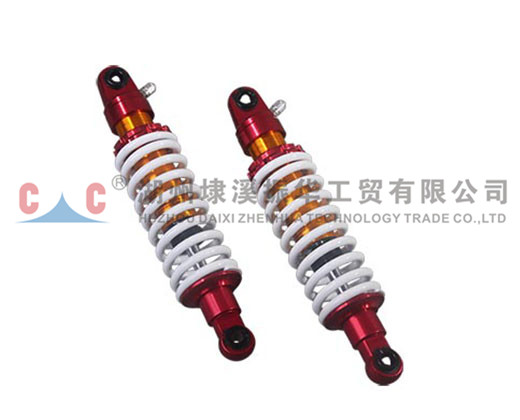The shock absorber of a motorcycle plays a big role in driving. When buying a car, many people will also care about the configuration of a car on the shock absorber. Structurally, the shock absorbers of motorcycles are divided into upright and upside down. Most riders know that the upside down shock absorbers of the same level have absolute advantages, but if you want to ask the reason, I am afraid that Most riders are at a loss. Today we will analyze in detail, what are the differences between the two, is it true that the reverse reduction is better than the positive reduction.
To understand the advantages of deceleration, you must first understand its structural principles. Whether it is positive or negative, it must be composed of the following components: shock absorber outer cylinder, inner cylinder, spring, damper, oil seal, dustproof Cover, and in order to connect with the body.
Front shock absorber outer cylinder
The outer cylinder and the inner cylinder can be moved relative to each other. With the oil seal, the shock-absorbing oil will not leak out. In addition, the outer cylinder of the front vertical reduction must also be designed with a mounting hole for the brake caliper and a mounting hole for the front axle to achieve its role of supporting the car. On the contrary, the inverted front reduction has the outer cylinder on the top and the inner cylinder on the bottom. The outer cylinder does not have this design. Both the caliper and the front wheels are installed on the inner cylinder.
Regardless of positive or negative reduction, the inner cylinder will be subjected to surface treatments such as electroplating. The purpose is to increase the surface hardness, which can reduce friction resistance and damage, and achieve the function of anti-rust. In appearance, it will appear mirror-like luster, and some inner tubes will also be plated with gold and brown, which looks quite dazzling.

Oil seal, dust cover
The oil seal is a very important mechanical component, which is connected to the outer cylinder and the inner cylinder to prevent leakage of shock-absorbing oil. A dust cover is also installed on the oil seal to prevent dust or mud from entering the oil seal and scratching the surface of the oil seal and the inner cylinder. However, some sports cars do not install dust caps in pursuit of smoother performance and lighter performance.
For a motorcycle, the front shock absorber has to support the weight of the car and handle the vibration, but also shoulder the steering function. Therefore, the strength of the shock absorber is also absolute for the handling and safety of the car.
Inverted front shock absorber
In the 1990s, a large number of inverted shock absorbers began to appear on mass-produced vehicles. Its shape is very similar to positive damping, except that the inner and outer cylinders were placed upside down, and the name of inverted damping was obtained. In terms of performance, the reduction has a higher overall rigidity and a more sensitive shock absorption effect, and has gradually become the main equipment of performance cars since the late 1990s. Up to now, whether it is a racing car, a super sports car, an off-road vehicle or a sports street car, most of them have used reverse reduction as the front shock absorber.
Size reduction
In the upright front shock absorber, the diameter of the inner cylinder is the focus of the design. For example, the front shock absorber of SUZUKI GSX1400 has a large diameter of 46mm in order to cope with the weight of the strong vehicle and the rigidity required for high-speed riding The size of the inner cylinder not only increases the manufacturing cost, but also the weight of the shock absorber cannot be controlled. When evolving from positive reduction to reverse reduction, if the required rigidity is the same, the diameter of the inner cylinder can be reduced, which is the relative advantage of the inverted shock absorber.
Increased rigidity
Rigidity has always been one of the selling points of reduction. Under the same inner cylinder diameter design, reduction can be stronger than traditional positive reduction. Therefore, under the same rigidity requirements, the reduced inner cylinder diameter can be smaller, so the overall weight of the shock absorber is lighter. The impact of the tire from the ground in all directions will be first transmitted to the front shock absorber.
Under the same conditions, the reduced steel is stronger
Reduce unsprung mass
The unsprung mass is the mass below the spring in the shock absorber. During the reduction, the inner cylinder is designed to the lower half of the overall front reduction. In addition to the inner cylinder diameter can be smaller, compared to the thicker outer cylinder, the mass It has also been made lighter. In the actual test, reducing the unsprung quality, the vehicle equipped with reverse reduction can make the shock absorber work more sensitively, which is why most cars that emphasize performance use reverse reduction!
Finally, let's make a brief summary of the two shock absorbers. The advantages of positive reduction are: relatively simple structure, easy maintenance and disassembly, and low cost. The advantage of the reduction is that the rigidity is stronger and the unsprung weight is lighter, which is convenient for vehicle control.